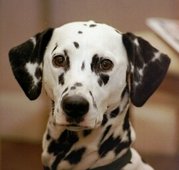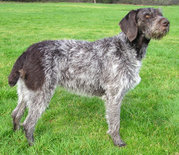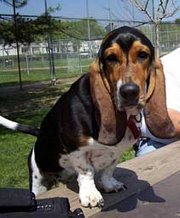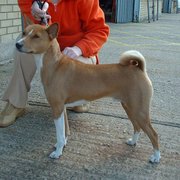Dog Anatomy
Dogs
Dog Anatomy
Coat | Cording | Debarking | Dewclaw | Docking | Hairless Dogs | Marcel | Merle | Natural Bobtail | Piebald | Snout | Withers
The anatomy of
dogs
varies tremendously from
breed
to breed, more than in any other animal species, wild or domesticated.
And yet there are basic physical characteristics that are identical
among all dogs, from the tiny
Chihuahua to the giant
Irish Wolfhound.
Physical characteristics
Like most predatory mammals, the dog has powerful muscles, a
cardiovascular system that supports both sprinting and endurance, and teeth
for catching, holding, and tearing.
The dog's ancestral skeleton provided the ability to run and leap. Their legs
are designed to propel them forward rapidly, leaping as necessary, to chase and
overcome prey. Consequently, they have small, tight feet, walking on their toes;
their rear legs are fairly rigid and sturdy; the front legs are loose and
flexible, with only muscle attaching them to the torso.
Although selective breeding has changed the appearance of many breeds, all
dogs retain the basic ingredients from their distant ancestors. Dogs have
disconnected shoulder bones (lacking the collar bone of the human skeleton) that
allow a greater stride length for running and leaping. They walk on four
toes, front and back, and have vestigial
dewclaws (dog
thumbs) on their front and rear legs just like monkeys' thumbs. In some cases
these claws are missing due to surgery, the rear dewclaws sometimes being
removed to prevent the possibility of them being ripped off, or catching on
something and breaking, especially in dogs with loose dewclaws. This practice is
illegal in some countries.
The dog's ancestor was about the size of a
Dingo, and its
skeleton took about 10 months to mature. Today's
toy breeds
have skeletons that mature in only a few months, while giant breeds such as the
Mastiffs take
16 to 18 months for the skeleton to mature.
Dwarfism
has affected the proportions of some breeds' skeletons, as in the
Basset
Hound.
Dog coats


Coat colors range from pure white to solid black and many other variations.
-
- For a complete detailed list of dog colors and patterns, see
Coat (dog).
Dogs exhibit a diverse array of
coat textures, colors, and markings, and a specialized vocabulary has
evolved to describe them.
Originally, dogs all had dense fur with an undercoat and long muzzles and
heads, although both of these features have been altered in some of the more
extremely modified breeds, such as the
Mexican Hairless Dog and the
English Bulldog.
Color
One often refers to a specific dog first by coat color rather than by breed;
for example, "a blue merle
Aussie" or "a chocolate
Lab". Coat colors include:
- Black:
Usually pure black but sometimes grizzled.
- Brown:
From mahogany through very dark brown.
- Red:
Reminiscent of reddish woods such as
cherry or
mahogany;
also tawny, chestnut, orange, rusty, liver, and red-gold.
- Yellow: From pale cream to a deep yellowish-gold tan.
- Gold: From pale apricot to rich reddish-yellow.
- Gray: Pale to dark gray, including silver; can be mixed with other
colors or various shades to create sandy pepper, pepper,
grizzle, blue-black gray, or silver-fawn.
- Blue: A dark metallic gray, often as a blue
merle or speckled (with black).
- Sable:
Black-tipped hairs; the background color can be gold, silver, gray, or tan.
- White:
Distinct from
albino
dogs.
Pattern
 The Dalmatian's
coat is one of the more widely recognized markings.
The Dalmatian's
coat is one of the more widely recognized markings.
Coat patterns include:
- Two-color coats, such as Black and tan, red and white. The coat has both
colors but in clearly defined and separated areas; usually the top and sides
are darker and lower legs and underside are the lighter color.
- Tricolor: Consisting of three colors, usually black, tan, and white or
liver, tan, and white.
- Brindle:
A mixture of black with brown, tan, or gold, usually in a "tiger stripe"
pattern.
- Harlequin: "Torn" patches of black on white.
- Merle: Marbled coat with darker patches and spots of the specified
color.
- Particolor: Two-colored coat with the colors appearing in patches in
roughly equal quantities.
Texture
Coat textures vary tremendously. Some coats make the dogs more cuddly and
others make them impervious to cold water. Densely furred breeds such as most
sled dogs
and Spitz types
can have up to 600 hairs per inch, while fine-haired breeds such as the
Yorkshire Terrier can have as few as 100, and the "hairless" breeds such as
the
Mexican Hairless have none on parts of their bodies. The texture of the coat
often depends on the distribution and the length of the two parts of a dog's
coat, its thick, warm undercoat (or down) and its rougher,
somewhat weather-resistant outer coat (topcoat, also referred to as
guard hairs).
Breeds with soft coats often have more or longer undercoat hairs than guard
hairs; rough-textured coats often have more or longer guard hairs. Textures
include:
 The
German Wirehaired Pointer's coat demonstrates a rough texture.
The
German Wirehaired Pointer's coat demonstrates a rough texture.
- Double-coated: Having a thick, warm, short undercoat (or down)
that is usually dense enough to resist penetration by water and a stronger,
rougher weather-resistant outer coat (topcoat), also referred to as
guard hairs. Most other coat types are also double-coated.
- Single-coated: Lacking an undercoat.
- Smooth-coated: "Smooth" to the eye and touch.
- Wire-haired: Also called broken-coated. The harsh outer guard
hairs are prominent, providing excellent weather protection for hunting dogs
such as the
Border Terrier or
Wirehaired Pointing Griffon.
- Long-haired: Hair longer than an inch or so.
- Short-haired: Hair around an inch or so long.
- Corded
coat: for example, see
Puli
Parts of the body
A special vocabulary has been developed to describe the shapes of various
body parts including the ears and tail.
Ears
 The
Basset Hound's ears are extremely long drop ears.
The
Basset Hound's ears are extremely long drop ears.
Dogs' ears come in a variety of sizes, shapes, lengths, positions on the
head, and amounts and types of droop. Every variation has a term, including:
- Bat ear: Erect, broad next to the head and rounded at the tip.
- Button ear: A smaller ear where the tip folds forward nearly to the
skull, forming a V, as in the
Jack Russell Terrier.
- Cropped ear: Shaped by cutting; see
docking.
- Drop ear: An ear that folds and droops close to the head, such as most
scent
hounds'. Also called a pendant ear.
- Natural: Like a
wolf's.
- Prick ear: Erect and pointed; also called pricked or erect.
- Rose ear: A very small drop ear that folds back; typical of many
sight
hounds and the
English Bulldog.
- Semiprick ear: A prick ear where the tip just begins to fold forward, as
in the
Rough Collie.
Tails
 The Basenji's
tail is tightly curled.
The Basenji's
tail is tightly curled.
Like ears, tails come in a tremendous variety of shapes, lengths, amounts of
fur, and tailsets (positions). Among them:
- Corkscrew: Short and twisted, such as a
Pug's
- Docked: Shortened by surgery or other method, usually two or three days
after birth; see
docking
- Odd: Twisted, but not short. Uncommon.
Tibetan Terriers have odd tails.
- Saber: Carried in a slight curve like a
saber
- Sickle: Carried out and up in a semicircle like a
sickle
- Squirrel: Carried high and towards the head, often with the tip curving
even further towards the head.
- Wheel: Carried up and over the back in a broad curve, resembling a
wheel.
Puppy Characteristics
Puppies often have characteristics that do not last beyond early puppyhood.
Eye color often changes from blue to its adult color as the puppy matures. The
coat color may change:
Kerry Blue Terrier puppies have black coats at birth and change to blue with
maturity, and
Dalmatians are white and gain their spots with age. The ear shape will also
often change, especially with erect-eared breeds such as the
German Shepherd Dog which have soft ears at birth, but the cartilage
strengthens with age.
It is not uncommon for puppies to have their ears cropped or straightened,
tails docked, or in the case of the
Chow Chow,
to have their eyefolds stitched back so that they can see. Many of these are
done in accordance with breed standards for many Kennel Clubs. Some countries
like Italy have
banned this practice as an act of animal cruelty.
Temperature Regulation
A common misconception is that dogs do not
sweat.
Primarily, dogs regulate their body temperature in a completely different way,
through their tongue. That is why after a dog has been running or on a hot day,
its mouth will be seen wide open with the tongue hanging out. This form of
cooling maximizes heat lost while conserving moisture, because it carries heat
from the hottest part of the body, the interior core of the
thorax, unlike
sweating, which cools the already coolest part of the body, the skin—or in less
intuitive, more scientific terms, this higher efficiency of thermal loss
relative to moisture conservation arises because
heat flow is proportional to temperature gradient. In addition, dogs
effectively sweat through the pads of their feet, since they are not furred. On
a warm day and after exercise, a dog's naturally wet footprints might be visible
on a smooth floor.
Dogs possess a
rete
mirabile in the
carotid sinus at the base of their neck, a complex of intermingled small
arteries and veins which acts as a
heat exchanger to thermally isolate the
head, containing
the brain, the
most temperature-sensitive organ, from the
body, containing
the muscles,
where most of the heat is generated. The result is that dogs can sustain intense
physical exertion over a prolonged time in a hot environment, compared to
animals which lack this apparatus; thus, a dog chasing a
jackrabbit through
the desert may
not be able to outrun the rabbit, but it can continue the chase until the rabbit
literally drops dead from overheating.
Home | Dogs | Dog Anatomy | Dog Breeding | Dog Breeds | Dog Equipment | Famous Dogs | Fictional Dogs | Dog Health | Dog Law | Dog Organizations | Dogs as Pets | Dog-Related Professions and Professionals | Dog Show | Dog Sports | Dog Training | Dog Types | Working Dogs | License
Dogs, made by MultiMedia | Free content and software
This guide is licensed under the GNU
Free Documentation License. It uses material from the Wikipedia.
|




